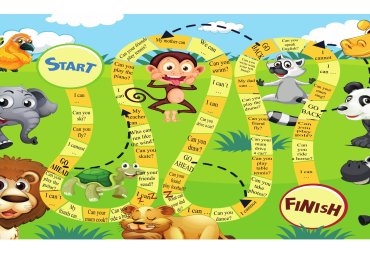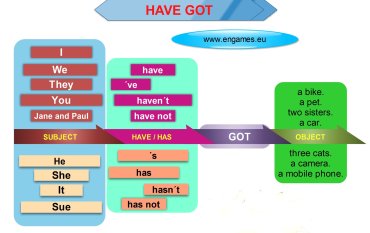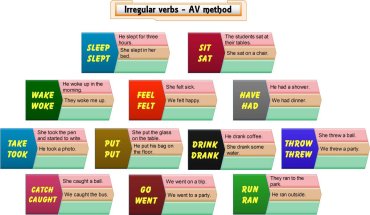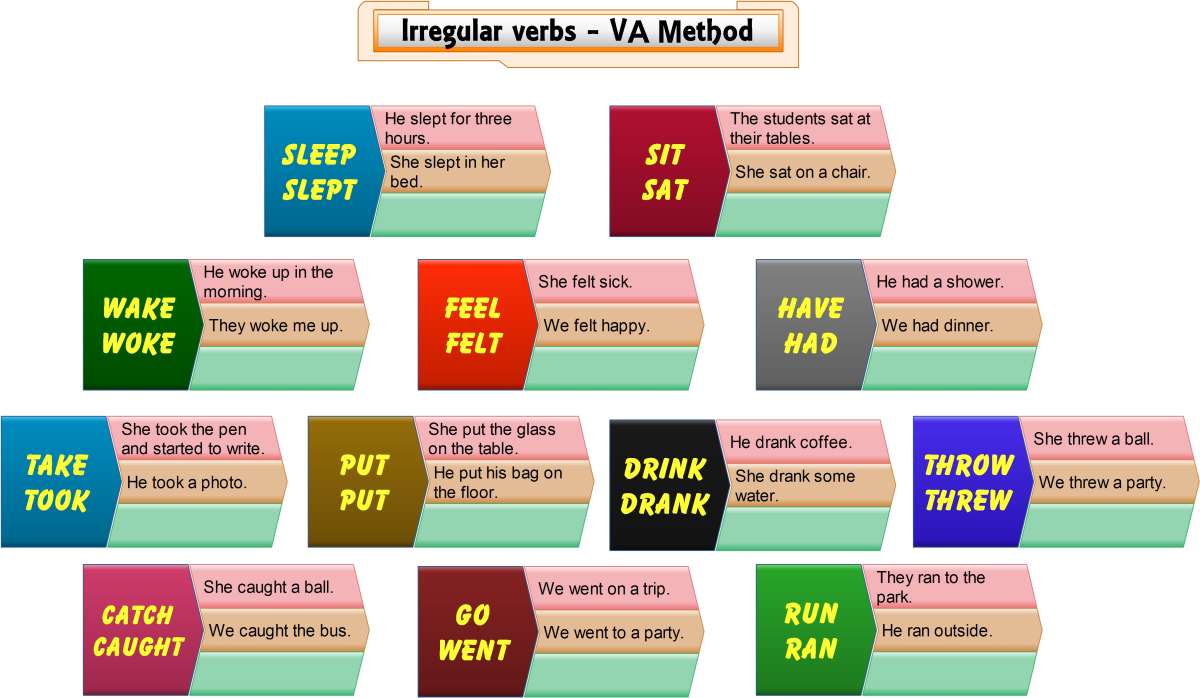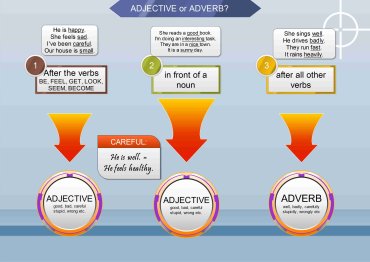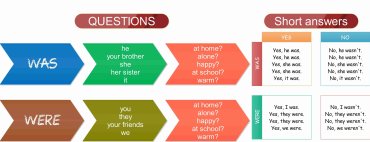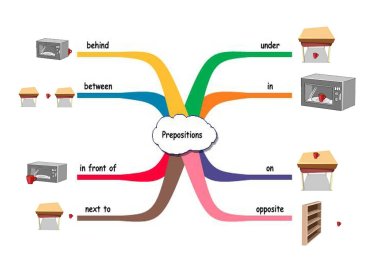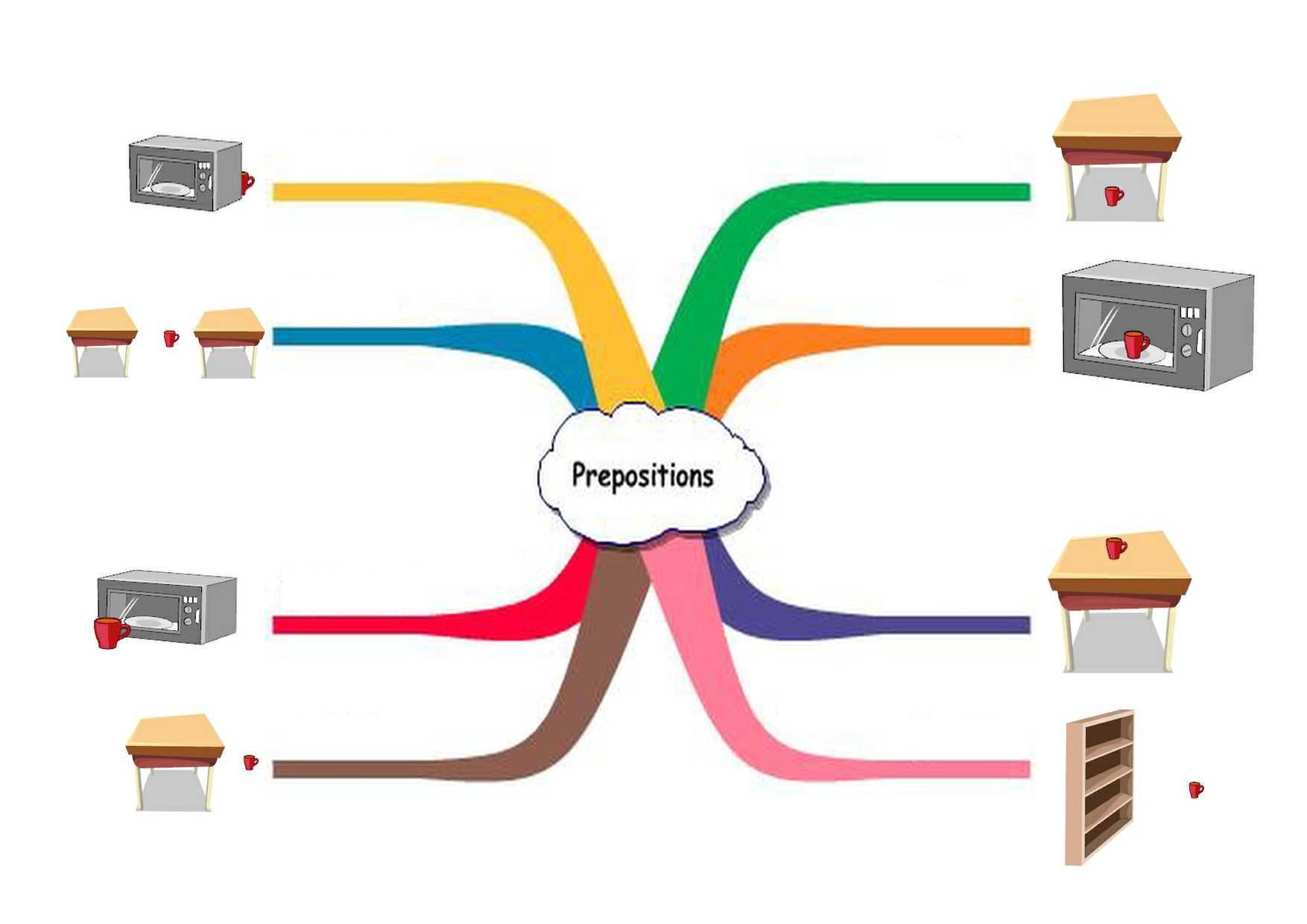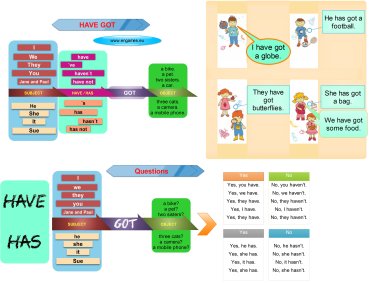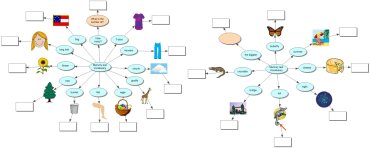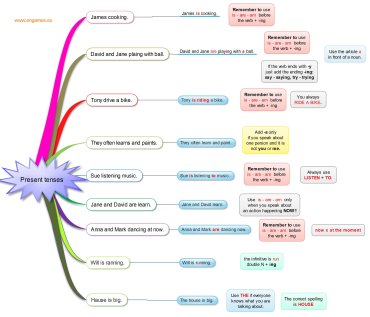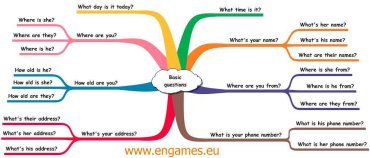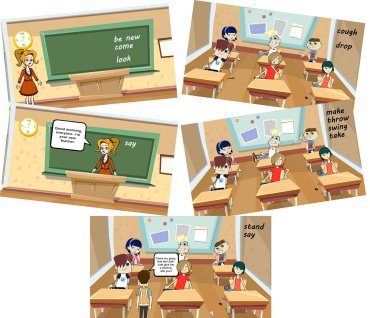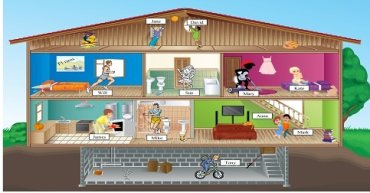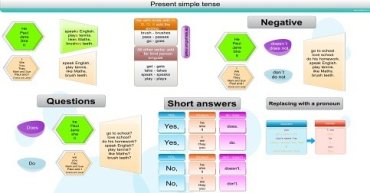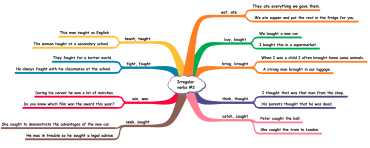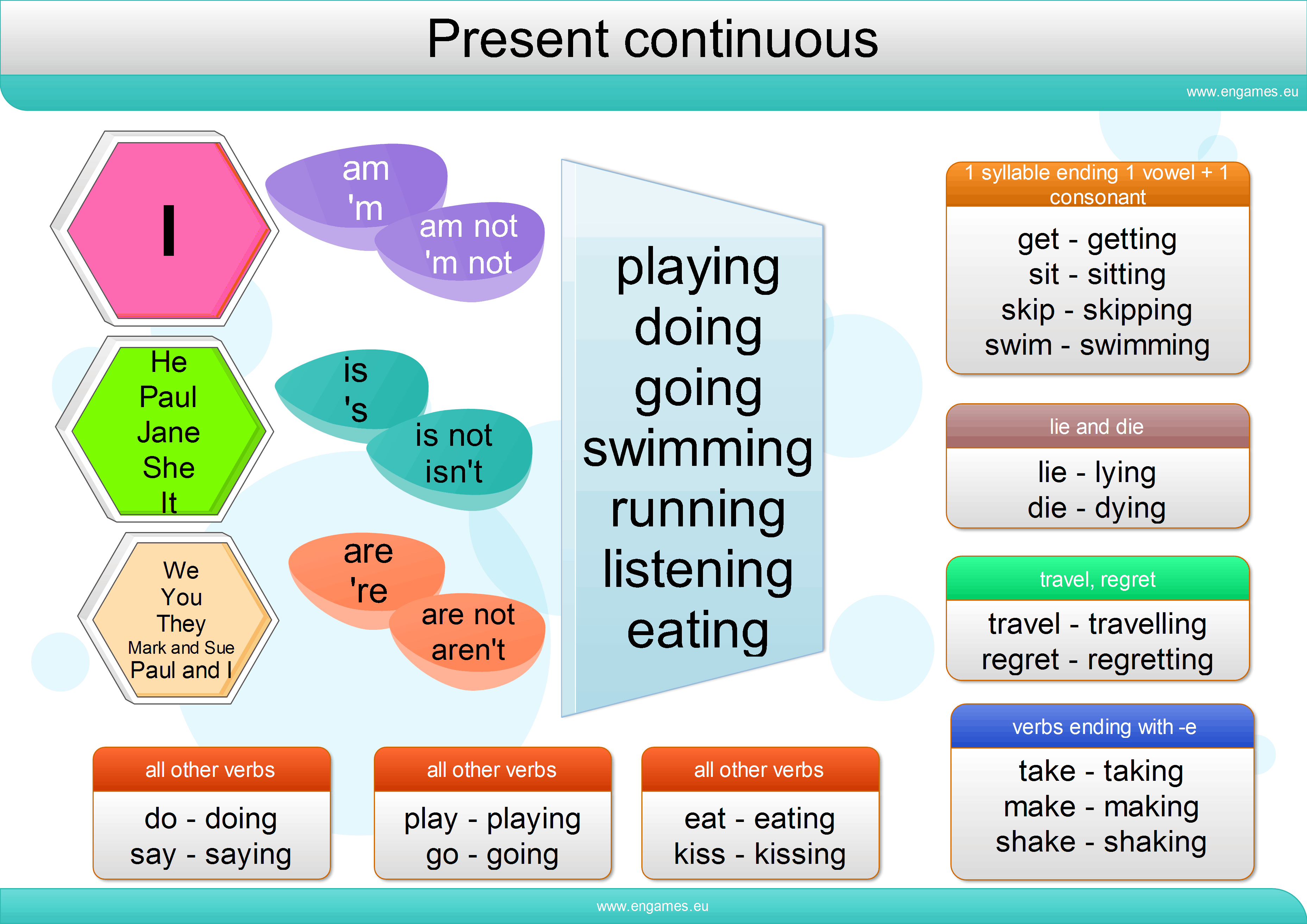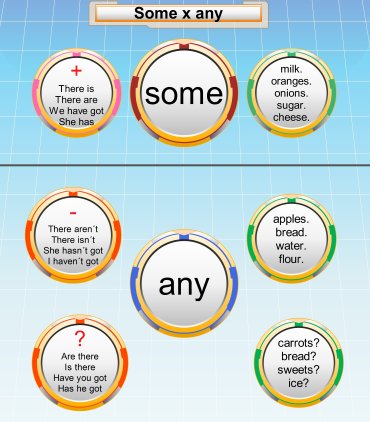Speaking activities are the best thing in teaching and learning a foreign language. However, students sometimes run out of ideas about what they should say or the language they use is far from the one we try to teach them. To solve the problem, I designed the CARD SPEAKING activity.
(more…)Category: Elementary, English games, Speaking activities
Play with your students this board game to practise the verb CAN. Students play the game and practice the grammar.
In this post, I would like to share the materials I have created recently to teach the verb HAVE GOT.
(more…)Recently I have published 4 posts on teaching irregular verbs. The posts were based on a rap song by Fluency MC. This post is different.
This time I am introducing a new method of teaching the past tense of irregular verbs. The method is called the Visual-Audio Method, and I think it is completely new. I have managed to try it out with only with one class so far, but I can say that it worked.
ADVERT:
[showmyads]
Irregular verbs – video
Here is the video for the Visual-Audio Method. It consists of three parts. In the first part the students listen to, read and repeat the sentences. In the second part they listen to the sentences and repeat them, but the words don’t appear on screen. In the third part they see the picture of the action and they have to supply the sentence before they hear it.
You should play the video at least once in each lesson for one or two weeks to ensure that the students remember the phrases.
Irregular verbs – infographic
The following infographic should help the students revise the words. You can ask your students to translate the phrases.
Irregular verbs – quizzes
Your students can test their knowledge of the past tense of the verbs in the following HTML5 quiz. The quiz will play on all mobile devices and desktop computers.
Irregular verbs Quiz
The following two games are in Flash and will play only on desktop computers. They are really fun. I often play them with my classes at school.
ADVERT:
[showmyadsa]
Irregular verbs Half a minute
Students often hesitate over whether they should use an adverb or an adjective in a sentence. And to be honest, I did not make it much easier for them with my explanations. So I decided to buckle down to work and create a simple system which will work for my students.
Here is the final result. I have created an infographic which helps the students decide what form they should use. Then there are two games to help them to practice what they have learned and an interactive quiz where they can test their knowledge.
Adverbs or adjectives – infographic
First, make sure, that your students know how to form adverbs. If they don´t, we have a great post on adverbs here.
ADVERT:
[showmyads]
Once you are sure your students can form adverbs correctly, show them the following infographic. Explain that they have to consider two factors when deciding whether they should use an adjective or an adverb. First, are any of the verbs mentioned in point 1 in the sentence? If so, they should use an adjective.
If not, they should consider point 2. Is the word in front of a noun and does it describe it? If so, they should use an adjective again.
In all other cases the students should use an adverb. I know it is just a rule of thumb, but it works most of the time.
You should not forget to mention that there is a difference between GOOD and WELL after the verbs in case 1. GOOD means not bad and WELL means fine or healthy.
Adverbs or adjectives – games
Now there are two games to practise the grammar in an enjoyable way. The first game is called On Target. Your task is to choose the correct option and then shoot all the bad ducks. You can shoot one of the bottles near the walls and thus earn a bonus.
The second game is called Penalty Shootout and students love it. Your task is again to choose the correct option and then score a goal.
Adverbs or adjectives – online quiz
Now you can practise the grammar in the following quiz. Students should fill in the correct answers and if they pass the quiz they will be rewarded with a game. Unlike the games above, this one is in HTML5 so it will play on all mobile devices.
Most placement tests are for adults. There are few placement tests for young students. Thus, when a teacher tries to test his or her students’ proficiency in English using a standard placement test, the students quickly become discouraged because they don’t understand anything. Then the final results tell you nothing about the students´ knowledge.
This placement test is different. It contains only 40 multiple choice questions, and it is for students who are at level A1 of the CERF. If the students get more than 28 answers correct, their English is at level A1 CEFR. If they get over 36 answers correct they are well into A2 CEFR level.
The grammar tested here contains only the verbs BE, HAVE GOT and CAN, present simple and continuous tenses. About half of the items test students´ knowledge of vocabulary and phrases.
Placement test
There are two versions of the test. The first one is an interactive quiz, which you can try here:
ADVERT:
[showmyads]
To play the quiz on the full screen click the button below:
Or you can try the paper version of the test here.
I hope the test will help you know your students better and choose the right level for each of them.
Other Placement tests
This placement test is for students 9-13 years old. If you are looking for a placement test for younger students, you can try the one that is here.
If you are looking for a placement test for adults, try this one.
You can try a placement test by Saint George Institute.
Questions with the verbs WAS and WERE are among the most common in English. Therefore it is vital for students to learn these questions well. They have to be able to form them, understand them and answer them.
To help you teach these types of questions, I have included the following activities in this post: an infographic explaining the grammar, a worksheet, a motivational song, a memory quiz and an online quiz. I hope you will find these useful and that your students will master questions with the verbs WAS and WERE.
Basic grammar rules – infographic
Display the following infographic to your students and explain that questions with WAS and WERE usually start with these words. Elicit that you can add a WH word in front of them.
ADVERT:
[showmyads]
Basic grammar rules – worksheet
I try to teach the grammar using a topic that the students are interested in. This time I have chosen the topic Selfies.
Start the lesson with the following song and ask the students to complete the lyrics in the first exercise in the worksheet.
Then play the video for the students and ask them to check their answers.
In the second activity, they should work in pairs and discuss the questions about selfies. If you happen to have a group whose English is not very good, have the students ask you the questions. That way you can demonstrate the way they should answer, and at the same time you can clear up the meaning of the questions.
Now ask the students to put the worksheets away and play the following video:
When the video finishes, ask your students to answer the questions as well as they can. Ask them to answer in full. Once they finish this task, tell them to check their answers and count 1 point for each correct YES or NO and 2 points if they gave a full answer (like, Yes, she was.)
Find out the winner and congratulate them.
Play the video again and ask the students to write their own questions for the pictures.
Ask them to work in pairs and to ask and answer their own questions.
In the last exercise, students work in pairs and give true answers to the questions.
Basic grammar rules – online quiz
The following online quiz contains a lot of different tasks which the students can do either as homework or at school. The quiz is in HTML5 and it will play on all digital devices.
Basic grammar rules – links
There are some great activities for learning and practising WAS and WERE at the British Council site.
I like teaching prepositions of place. I can use the Cuisenaire rods, and my students can be creative in many ways and use English a lot.
Here I would like to share the activities I use to teach prepositions of place. In this post you can find the following activities: a mind map, an infographic, a worksheet and online exercises.
Prepositions of place – infographic
First, I introduce the prepositions of place using the following infographic. If you have an interactive whiteboard in your English class, you can display it there, or you can print it and hand it out to everyone in the class.
ADVERT:
[showmyads]
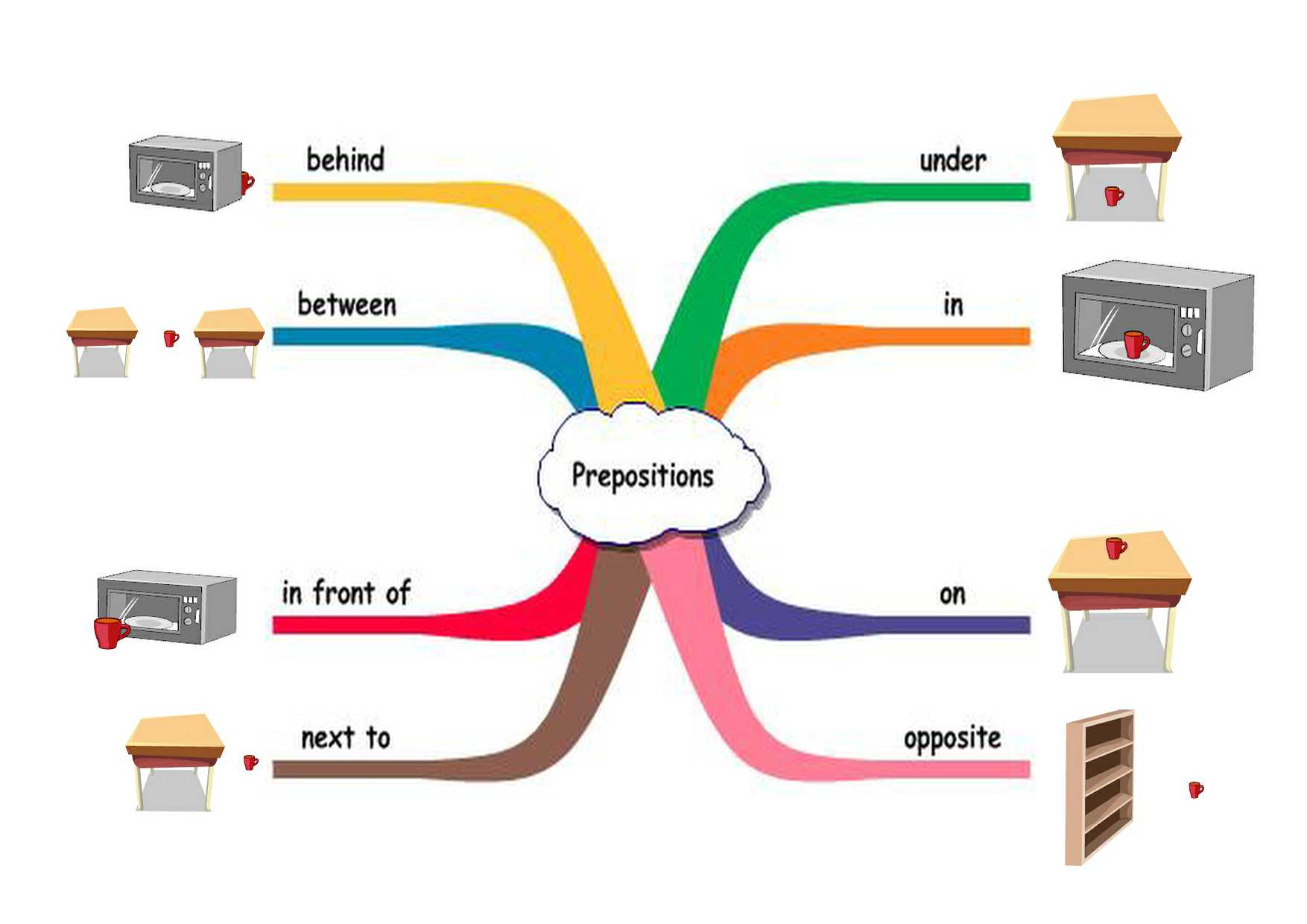
Then display the following mind map and elicit the prepositions.
Prepositions of place – worksheet
Hand out the following worksheet to your students. There are four pages and it is best to print out two pages on one sheet.
Prepositions of place worksheet
First you need to practise the names of pieces of furniture with your English class. You can find a furniture vocabulary post here.
Ask your students to solve the crossword and word search and then check their answers.
The second page concentrates on the prepositions. Ask your English class to figure out the names of the cats using the clues on the right.
In the task that follows, students should complete the sentences using the correct prepositions.
On the third page there is another infographic to introduce the meanings of the prepositions of place.
If you have a monolingual class and you speak their mother tongue, you could ask them to translate the sentences.
In the last task on page four, students have to place the pieces of furniture in the room. Then they have to describe their room to their partner and the listener has to draw the room.
Prepositions of place – Cuisenaire rods
My English classes love this activity. I bring the Cuisenaire rods and I give each pair of students a set. First, I tell them that they have 3 minutes to play with the rods.
After the 3 minutes I ask them to stop playing and put all the rods in the box. Then I dictate sentences like: Put the red rod on the table. Put the green rod under the red rod. Put the white rod next to the red rod.
I dictate 5 sentences and then we check the resulting shape.
In the next phase students work in pairs. One of them dictates and the other puts the rods on the table. After a while they swap their roles.
Prepositions of place – online quiz
You can either ask your English class to use the following online quiz at home or you can do it at school if you have enough computers.
As the quiz is in HTML5 and should play on every mobile device, you could even ask your English class to do the quiz on their mobile phones.
In the quiz there are several slides with questions. If the students pass the quizzes, they can play a game.
Prepositions of place – full screen
Prepositions of place – links
There are some great activities for learning and practising prepositions of place at the British Council site.
For an unknown reason many elementary textbooks teach HAVE GOT at the very beginning. Students find it difficult and they get confused. Moreover, they get even more fed up when they learn that the Americans do not use this form.
But I have to teach the grammar, so there is no use crying over spilt milk. To be honest, I was not very successful the last time I taught this grammar, and that is why I decided to create some new materials.
In this post you will find a song, an infographic, a worksheet with communicative activities, and an interactive online quiz.
Have got – song
Start the lesson with the following song. Ask the students to listen and complete the lyrics. Check their answers and ask the students to listen and sing along. In this way they will practise their pronunciation and grammar at the same time.
ADVERT:
[showmyads]
Have got – infographic
Now draw the students’ attention to the following infographic. Explain the form of the verb have got. This may be the right time to drill the form.
Once you have explained the grammar, it is time to practise it using the following worksheet. Download it and print it out.
Have got communicative worksheet
Ask the students to work in pairs. They must not show their pictures to their partners.
In the first exercise they look at their picture and write what they have in the bag.
In the second exercise they write questions asking whether their partner has the same things in their bag . When the students finish writing their questions, they work in pairs and ask and answer in pairs.
In the third exercise, the students look at their bags. Then they look at the objects on the right. They ask their partner whether Jane or David has these things in their bags. They tick or cross out the objects in their pictures.
Have got – online quiz
The following quiz can be taken at school or you canask your students to do it at home.
In the first part, the students should write correct sentences about the pictures using HAVE GOT. If they produce enough correct sentences, they will be able to play the game called Angry Farmer.
In the second part of the quiz they should first match the pictures and the words and then write them. In the last part of the quiz they have to write the correct answers. Again, if the students pass the quiz they will be rewarded with a game. This time they should write the words they see in the picture (of course, in English).
ADVERT:
[showmyadsa]
Recently I have felt that my lessons are not language rich. And that is something no EFL teacher is happy about.
For example, I have been teaching questions to my fourth graders. We learnt all the vocabulary and grammar, but when I asked my students the questions, they were not able to answer. They did not understand the questions even though they knew all the words and grammar.
ADVERT:
[showmyads]
In this post, I provide a series of entertaining activities in which students can practise and come to understand simple questions.
Vocabulary
First, teach the following vocabulary. Read the words aloud and ask your students to repeat them. Then ask them to memorise the words. Give them only three minutes for this. Then ask the students to cover the words inside the circle and write the words in the outer boxes.

Do not forget to explain the phrase “the biggest” as there is no picture for this word.
Memory test game
Ask the students to take a piece of paper and a pen. Play the following video and ask them to answer all the questions. They should answer them as simply as possible.
Ask the students to check their answers at the end of the video. Find out who remembered the most in your class and reward them.
The memory game
Now tell the students that you will play the same game, but this time they have to put the words in the questions into the correct order first. They will get one point for each correct question and one for each correct answer. The picture will show for only 5 seconds, but give the students enough time to write their questions and answers on a piece of paper.
ADVERT:
[showmyadsa]
Memory test grammar – full screen
Display the pictures at the end, and ask your students to write their own questions. Then ask them to work in pairs and ask their partner the questions.
Present simple and present continuous are easy tenses to learn in English. However, as simple as they are, there are still many students who make mistakes in these English tenses. For this post I have collected the most common mistakes my students make. I believe it is much better to learn from the mistakes others make than to make them yourself and feel stupid.
ADVERT:
[showmyads]
I have included the following activities in this post to help your students avoid mistakes in present tenses: a mind map, a worksheet, an online game on present tenses and an online quiz. I hope you and your students will find them useful.
Present tense – mind map
Ask your students to study the following mind map:
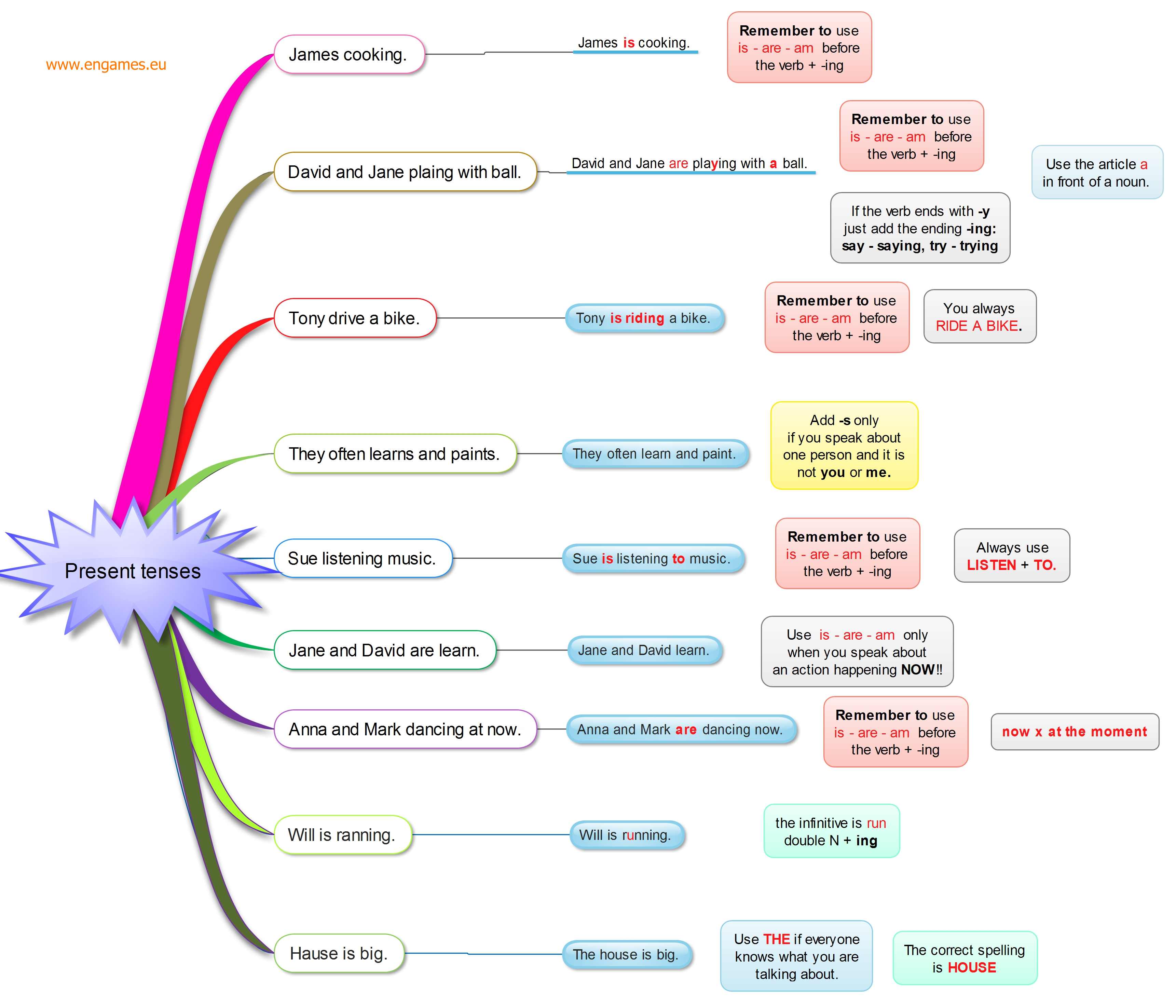
The sentence in the white fields are the mistakes, in the blue fields there are the corrected sentences and at the end, there are explanations.
You should emphasize the fact that students most frequently leave out the verb TO BE in the present continuous tense.
Present tense – online quiz
I have prepared two online quizzes this time. The first one is in Flash and it will play only on desktops. The aim of the game is to highlight the mistakes students make in English tenses. In the game students should choose the correct option and then shoot all the bad ducks. They can shoot a bottle on the side of the screen and get a bonus.
The second is an online quiz in which the students should fill in the verbs in the correct form of the present tense. The passing grade is set to 75%. As this online quiz is in HTML5, they can do it on their mobile devices too.
Present tenses – online quiz
ADVERT:
[showmyadsa]
Present tense – worksheet
The following worksheet contains only two activities. The first one is called Hidden Picture. The students should colour the squares that contain a correct sentence. If they colour the squares correctly, a shape will emerge.
The second activity is a simple fill in the gap exercise. The students should complete the sentences with the correct form of the verb.
Present tenses worksheet
Present tenses – download
More often than not I teach in classrooms with no internet connection, so I realize that it is important to be able to use the activities offline too. You can download the online quiz, the game, and the picture and use them offline:
Common mistakes present_tenses
When students start to learn English as a second language, there is a set of basic questions in English they need to master. All language courses start with these questions, but many people struggle to learn them. It is necessary to learn these by heart. However, you also need to be able to vary them a bit.
To help you teach or learn these questions I have devised the following activities: a mind map showing the basic questions for students of English as a second language, a worksheet with several communicative and drilling exercises, a song to help in memorising the questions and an online quiz. If you like the activities, please do not hesitate to comment below.
Basic question – song
I love starting lessons with something interesting. Students like songs, so I start the lesson with a simple song containing all the basic questions students of English as a second language need to learn.
Ask the students to listen to the song and complete the following worksheet:
Song lyrics fill-in
Play the song twice and then play the song on a whiteboard and ask the students to check their answers.
Basic question – mind map
Ask the students to have a look at this mind map and deduce the meaning of the questions – using the lyrics and the mind map.
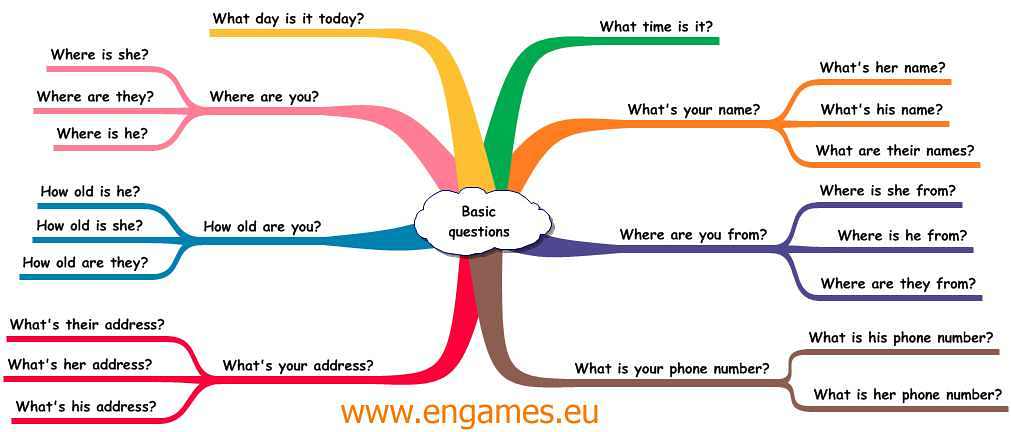
Ask the students to work in pairs and ask each other these questions.
Basic question – worksheet
The following worksheet contains several activities. First ask the students to find the questions for the fields a-g (students should only write the letters next to the questions below). Check their answers and tell them to ask you the questions and complete the table with your answers.
Ask them to find the questions for fields 1-7. Check their answers. (It is best to display the correct answers for both groups).
Have your students work in pairs (worksheet A and worksheet B). Ask them to ask the questions and complete their worksheet.
The next task is pure text manipulation. The students should fill in the missing words.
In the third exercise, students should put the words into the correct order to form questions.
In the fourth exercise students are given the answers, and have to write the questions.
In the last exercise students should write the questions using different pronouns.
Basic questions – communicative activities
Basic question – online quiz
In the following online quiz the students should first put the words into the correct order to make questions.
Then they should complete the questions. The online quiz is in HTML5 so it will work on all mobile devices. Students can practise wherever they like.
The second online quiz is in Flash and will play only on desktops. The aim of the game is to choose the correct question and then hit the opponent.
Basic questions – En garde game
Basic questions – download
More often than not I teach in classrooms with no internet connection, so I realize that it is important to be able to use the activities offline too. You can download the online quiz, the game, and the picture here and use them offline.
Teaching irregular verbs in context is not only useful, but rewarding too. A short story attracts the attention of students and can be used in many communicative activities. Unfortunately, there are not many short stories which can be easily used for teaching the past tense.
Advert:
[showmyads]
Luckily, my friend Lynne Blackburn sent me a nice short story to use here. With this post you can teach 8 irregular verbs and practise the past tense of regular verbs. There are many interesting activities which will make it easier for you to teach and for your students to learn. In this post you will find a video, a worksheet, a picture and an interactive exercise. I hope you will find them useful and interesting.
Irregular verbs in context – the story
Here is the story. First, ask your students to have a look at the picture and figure out what happened.
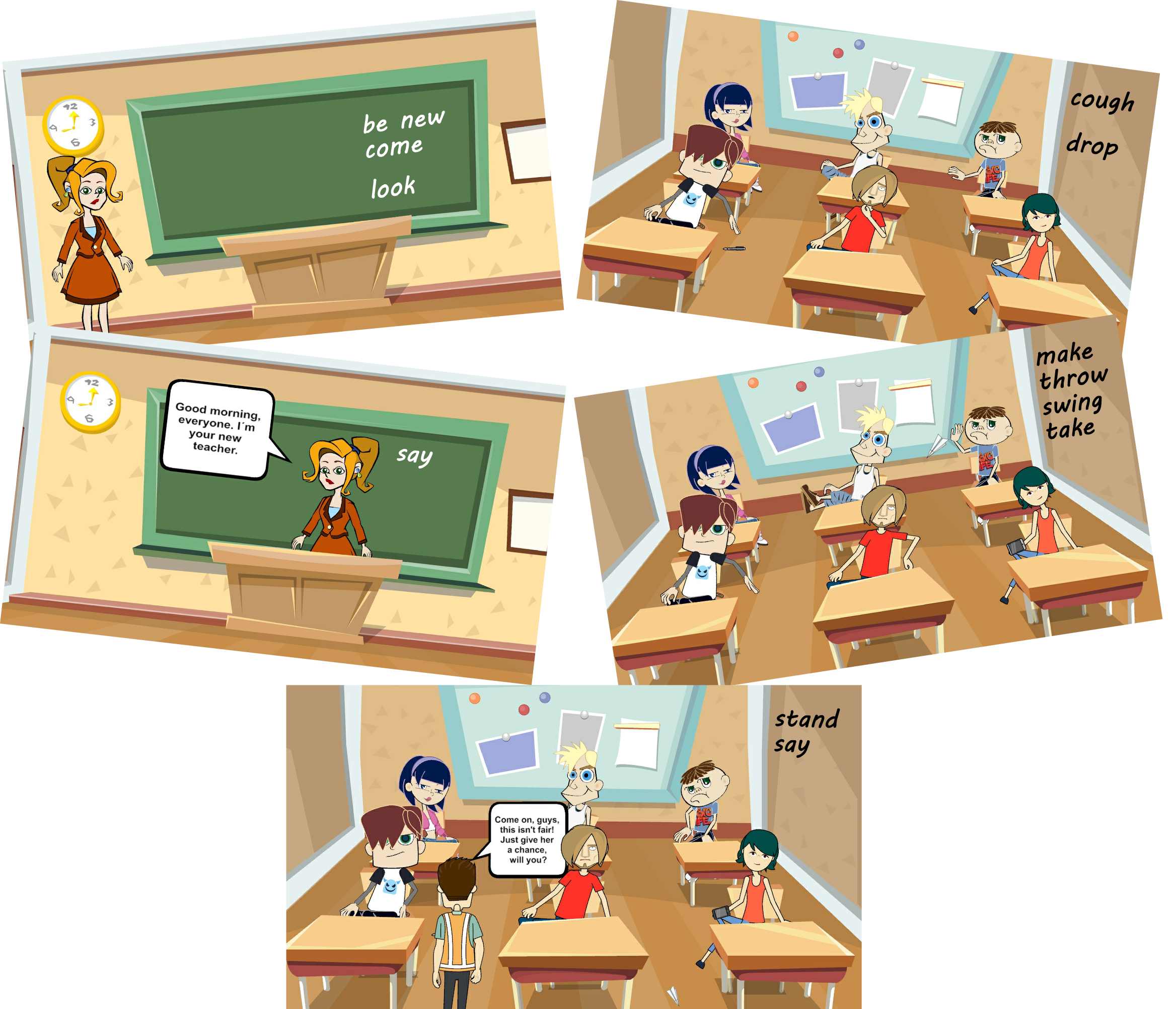
Once, you think the students have had enough of guessing, play the following video.
Irregular verbs in context – the worksheet
After watching the video, it is time to start using the worksheet. Download the following worksheet and print one copy for everyone.
Ask the students to translate the words in exercise one. They can use dictionaries or their mobile phones to do this.
Then ask the students to read the story again and answer the comprehension questions. You can find the correct answers in the key at the end of the worksheet.
In the third exercise students should complete the text with the correct verbs in the past tense. They can do so either in writing or orally.
The fourth exercise is called Grammar Up. You can find detailed instructions for this exercise in the following video:
In the fifth exercise students should complete the sentences with the correct conjunction. The correct answers are again in the key.
In the sixth exercise students should match the opposites.
In the seventh exercise students should find nine verbs in the past tense.
In the last exercise students should retell the story.
Irregular verbs in context – online quiz
Your students can practise the grammar at home or on their mobile devices in the following online quiz:
ADVERT:
[showmyadsa]
Irregular verbs – interactive quiz
Irregular verbs in context – other posts
If you would like to use more stories like this, you could try the following:
- Irregular verbs in context – Scream
- Irregular verbs in context 1
- Teach 9 irregular verbs in one lesson
Irregular verbs in context – links
If you would like more practice with irregular verbs, the British Council has a great site.
Irregular verbs in context – share
If you do not have an internet connection at school, you can download the video and online quiz here. Unpack the files and find the index.html and play the quiz.
I have already created two posts on the difference between the present simple and continuous tenses. There are Present simple or present continuous tense – improved and Present simple and continuous tenses posts. Both of them are good but as I have come up with a new idea, I want to share it with you in this post.
This post concentrates on the difference between the tenses. If you are not sure about the form of the tenses, you should see the following posts first:
ADVERT:
[showmyads]
In this post there are just two activities: a worksheet and an interactive quiz. I hope that they will help you with teaching the difference between the tenses.
Present simple and continuous tense – worksheet
Hand out the following worksheet (students have to work in pairs; one will need worksheet A and the other worksheet B) and ask the students not to show their picture to their partner. Ask them to describe what the people, whose names they know, are doing. Their partner has to listen and complete their own picture by filling in the names.
In exercise 2 they should complete the sentences with the correct names.
When they finish, it is time to explain the difference between the tenses. The present continuous tense is used to describe what the people are doing right now. However, when the students have a look at the rooms in their pictures they will see several objects there. For example, in the kitchen there is a basketball. James is not playing basketball now, but he plays it sometimes and that is why the ball is there.
You can go on like this with three or four more pictures. Then ask the students to complete exercise 3.
In exercise 4, students should take the picture and speak about it for 60 seconds without stopping or hesitating. Will they manage?
In the last exercise, ask the students to turn the paper over and write 10 sentences about it.
Present simple and continuous tense – worksheet
Present simple and continuous tense – interactive quiz
The following interactive quiz is based on the picture in the worksheet. It is ideal for homework or for a class where everyone has a smart phone with an internet connection. The quiz is in HTML5 and therefore will work on all mobile devices.
In the quiz students will practise the grammar they’ve learnt in the worksheet.
ADVERT:
[showmyadsa]
If you want to have the quiz on the full screen click the button below.
Present tenses – Full screen
Present simple and continuous tense – more practice
If you need more practice, you could try the following pages:
British Council page on present simple and continuous
Here are two useful videos:
Present simple is one of the most important tenses in English. It is quite easy to teach and learn but it must be done properly. In this post I am going to teach some vocabulary first and then teach the forms using the verbs.
ADVERT:
[showmyads]
In this post you can find a worksheet, a video and an interactive quiz to teach the vocabulary for daily activities. Once your students know the verbs it is time to introduce the forms – present simple tense affirmative, present simple tense negative and present simple tense questions.
Daily activities
First have a look at the following pictionary:
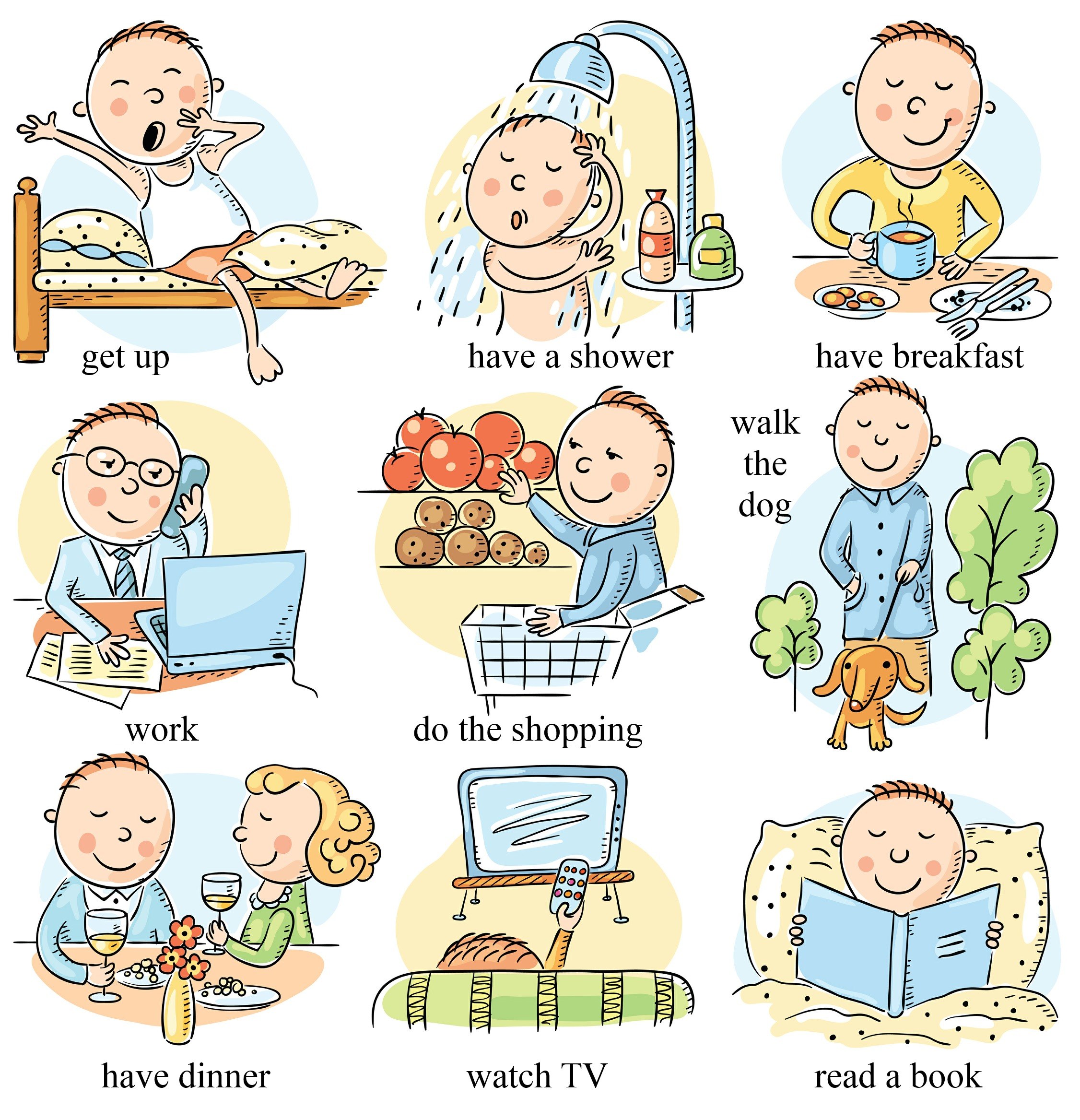
If you need the pronunciation, you should try the following video. In the second part of the video there is a quiz to practise the words. There appear the words and you have about 3 seconds to say the word before you hear it.
Daily activities – worksheets
To practise the vocabulary there are several activities. The first one is an interactive quiz. You have three tasks. First, match the words and the pictures, second, click the correct image and third write the words. The quiz is in HTML5 so it will work anywhere.
If you would like to play the quiz on the full screen, click the following button.
Daily activities – quiz
There are four more activities in a print form. Print out the following worksheets and solve them:
Daily routine_worksheet
When the students know the vocabulary, I believe it is time to introduce the grammar.
Daily activities – song
Here is a short song to practise the daily activities. It may serve as a good way to introduce the grammar too, as all the sentences are in present simple tense.
You could just play the song to the students or you could ask them to listen and complete the lyrics
I wake up in the morning
Present simple tense – grammar
Here is the infographic for present simple tense:
ADVERT:
[showmyadsa]
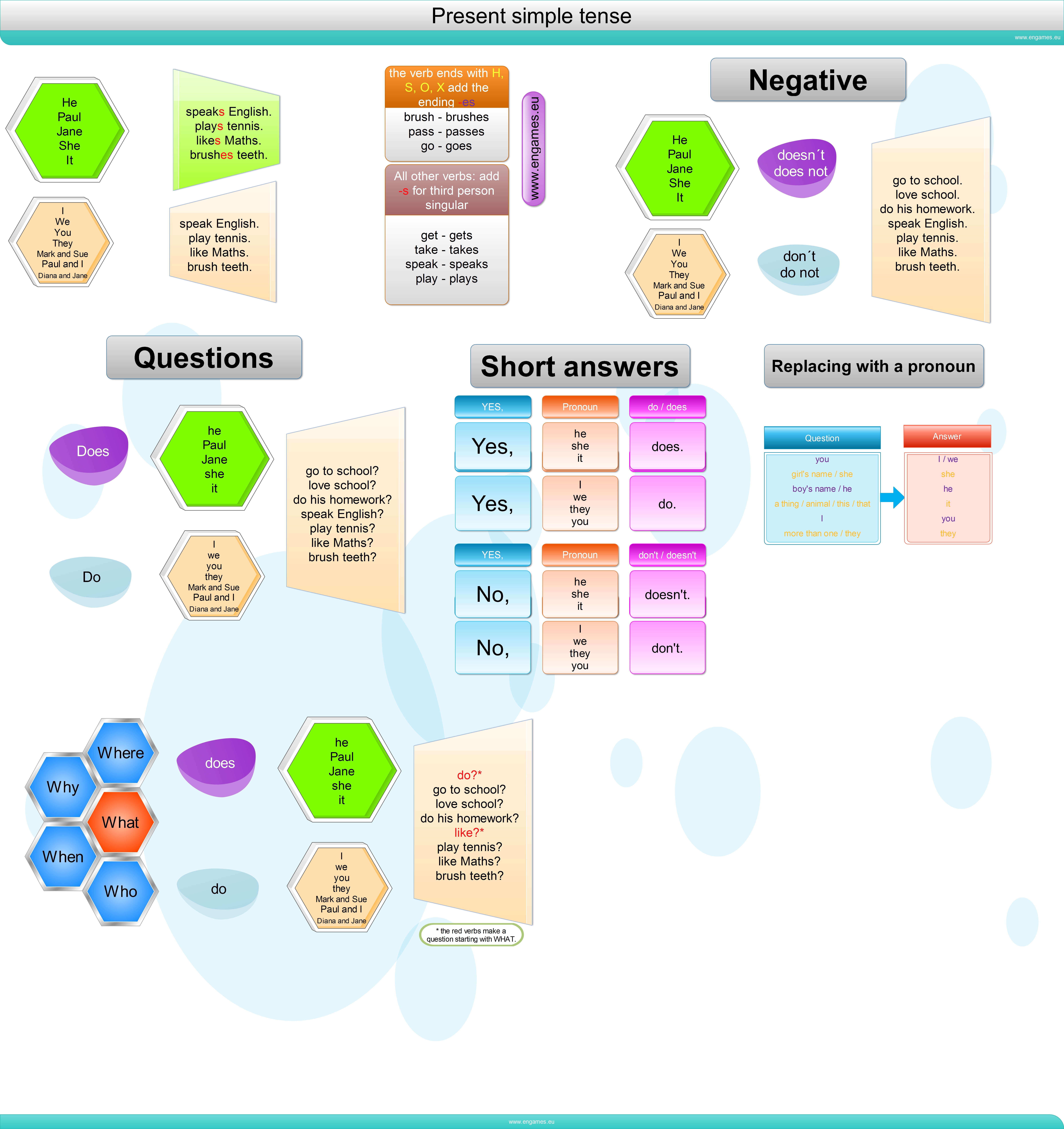
The infographic contains a lot of details. If you think it would be too much for your students, feel free to cut it into parts and present the different forms at different times.
Present simple tense – stories
To help my students remember the grammar, I tell stories. I tell them in their mother tongue as their purpose is to help the students remember the grammar. I have already presented the story about questions here and you can find it in our post on Questions.
Here, there are two more stories to highlight the grammar.
The first story explains why people use the ending -s in third person singular.
In English there is the sound PSST which is used to draw someone’s attention. A long long time ago people did not gossip. But then they started to speak about someone else but no one listened. But those people who gossiped needed attention so they started to use the PSST sound. They said:
Nikola (use students’ names, it is more fun and people listen) cook PSST very badly.
Adam play PSST football. Jane like PSST English. And so on.
And as people spoke quicker and quicker they soon reduced the PSST sound to the ending -s. So ever since when we speak about 1 person who is not me or you, we use the ending -s.
The other story explains the usage of DON’T.
Do you know what sound do bells make in English. DING DONG! It is very important because I will tell you a story that happened in the year 756. On 15th June suddenly three bells fell from a church tower in the English town Epston and they became alive. Suddenly they had legs and they walked around the country. And they spoke. People came to them and they asked them. “Do you live here?” “We,” started the bells but suddenly the sound DONG came from inside, “DONG live here.”
“Do you like music?” people asked.
“We DONG like music?”
“Do you do any work?”
“We DONG work.”
People spoke about these bells everywhere. “They dong like music.” “They dong work.” And as the time passed they changed the DONG sound to don’t and ever since we use DON’T in negative sentences. Later people added the form DOESN’T in third person singular.
And what happened to the bells? As they could not do anything they put them back on the tower and they never became alive again.
Present simple tense – grammar practice
To practice the grammar I have created the following interactive quizzes.
The first quiz is a game calleed On Target. Your aim is to choose the correct answer and then shoot as many bad ducks as possible. You can shoot a bottle on the side too and win a bonus. The game is in flash and it plays on desktops only.
To play the game on the full screen, click the button below.
Present simple tense – On Target
The second quiz is in HTML5 and thus it will play everywhere.
To play the game on the full screen, click the button below.
Present simple tense – Communicative activities
You might miss here a worksheet with some communicative activities. So do I. But as I do not have any I would like to ask you to send me yours. If it is good and I decide to publish it here, I will Paypal you 10$. Please send the worksheets to rotreklzdenek@gmail.com. Thank you.
Remember the worksheets have to be your own.
Teaching irregular verbs can be fun. The verbs are easy to use to tell stories and stories are interesting for everyone.
In the following post I am going to tell a story and you can learn the past tense of ten irregular verbs there.
ADVERT:
[showmyads]
To achieve this there are a video, a worksheet, a comic and an interactive quiz. I hope you will find them interesting.
Scream story – video
Watch the following story. The story is easy to follow as the colour follows the voice.
If you prefer telling the story yourself, you can use the following comic:
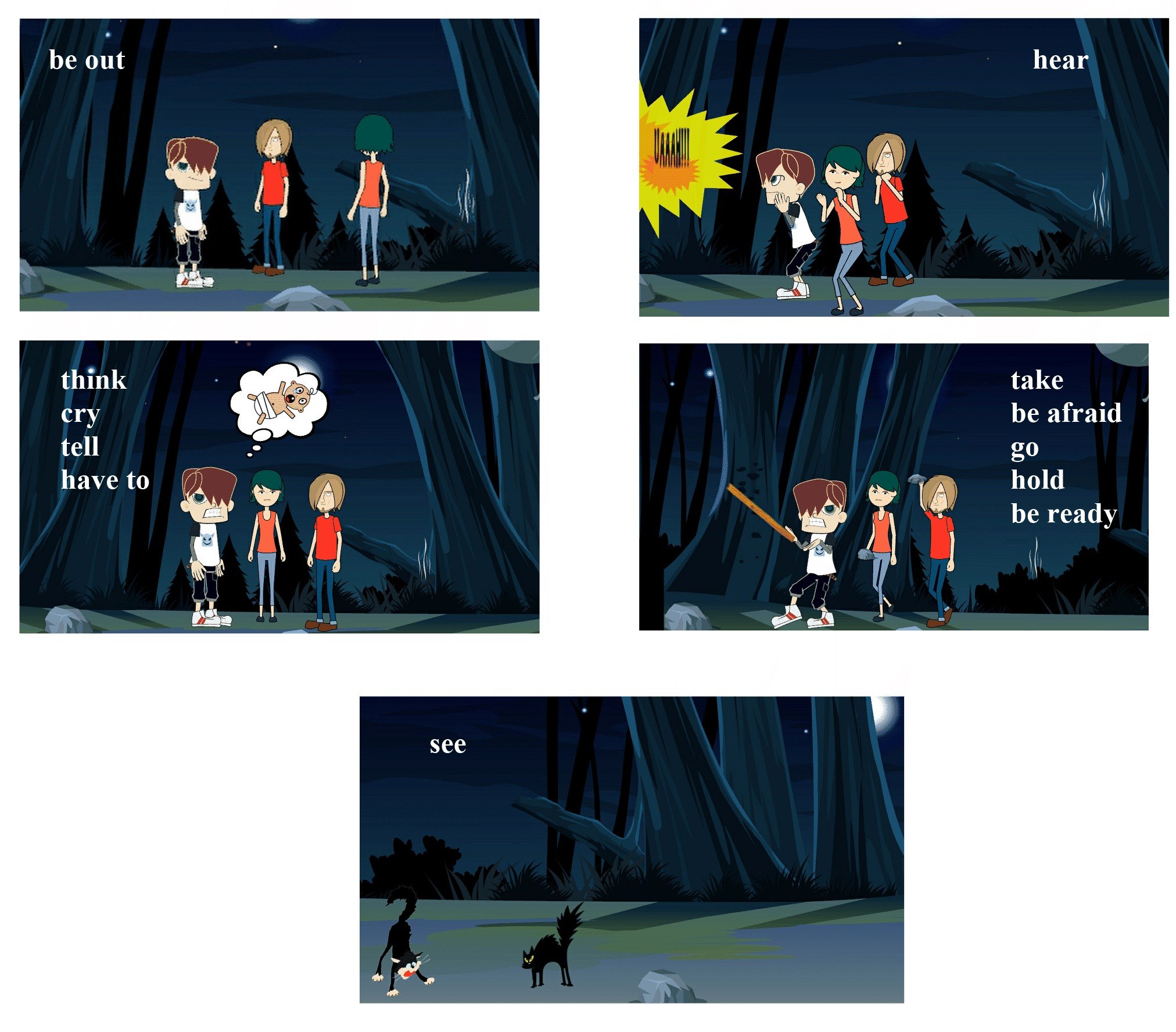
Scream story – worksheet
Once you introduce the story, it is time to deal with the language. First, translate the words in the table and then ask the students to read the story again and answer the comprehension questions. Of, course you can play the video instead.
Then ask the students to complete the text and in the end ask them to solve the crossword. Once they solve the crossword using the past tense ask them to work in pairs and retell the story using the comic.
Past-simple-story_scream_original_ws_better
Irregular verbs – interactive quiz
When you finish the worksheet, you can ask the students to do the following interactive quiz. As the quiz is in HTML5 they could try it out on their mobiles or you could do it on an interactive whiteboard.
If you want to play the quiz on the full screen, click the button below.
IRREGULAR VERBS SCREAM STORY
Irregular verbs – share
If you like the quiz above and you would like to share it on your blog or use it in a classroom without an internet connection, you can do this. You can download all the files here and upload them to your site just unpack the files and use them in the classroom:
ADVERT:
[showmyadsa]
Scream
Irregular verbs – more resources
If you would like to practise a bit more, here are several resources you might like.
Irregular verbs in context
Teach 9 irregular verbs in context
Several videos:
Other sites:
British council site
Learn English for teenagers
I have already published a post on possessive case. But when I tried to teach it again, I found out that it was not clear enough for the group I am teaching now. So I created a new infographic and several new interactive exercises in which students can practise the grammar. And my new students understand it now nearly perfectly. I hope you will find these materials useful too.
ADVERT:
[showmyads]
Possessive case – infographic
Have a look at this infographic and see how we form the possessive case in English.
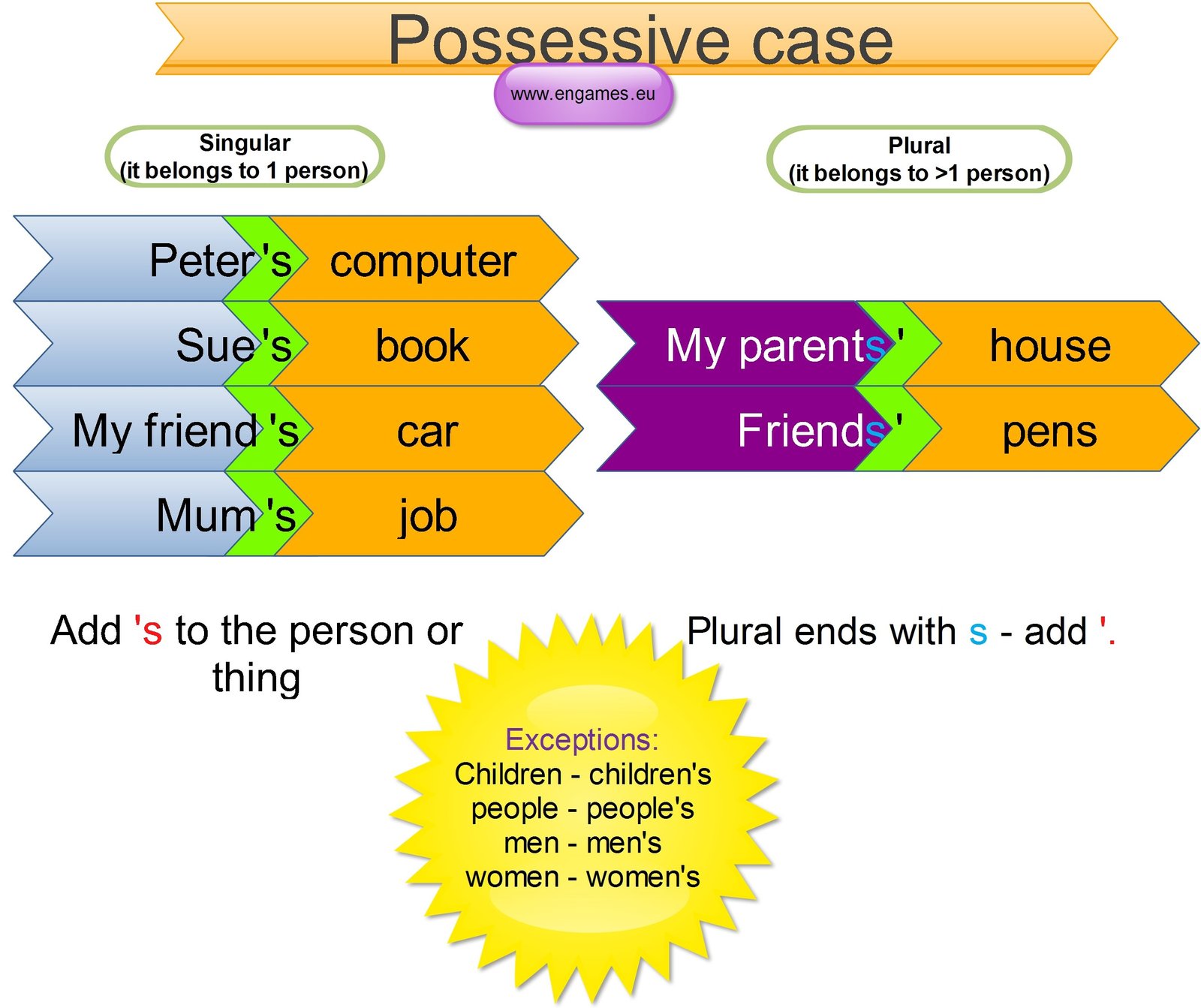
To cut the explanation short, add the apostrophe+s to a singular noun and add only the apostrophe to a regular plural noun. If the noun has an irregular plural add the apostrophe+s. If you feel that you understand the grammar, it is high time to practise it in the following exercises.
Possessive case – quiz
The following quiz is in HTML5, so it will work on all mobile devices. Thus your students can practise the grammar anywhere they like. If they pass the quiz they will be given a chance to play a game as a reward.
If you feel that the quiz is too small, click the button below and play the game on the full screen.
Possessive case – quiz full screen
If you are looking for more practise I recommend British Council page on possessive case.
Possessive case – share
If you like the quiz above and you would like to share it on your blog or use it in a classroom without an internet connection, you can do this. You can download all the files here and upload them to your site just unpack the files and use them in the classroom:
ADVERT:
[showmyadsa]
Possessive case_quiz (Web)
It is much more memorable to teach or learn irregular verbs in a story. The verbs, especially their meaning, are easier to remember and retrieve from memory. Moreover, teaching verbs in a story is fun.
In this post there are several activities: a mind map, a worksheet, an MP3 drill and an interactive quiz. These activities will make the teaching and learning enjoyable and fun.
ADVERT:
[showmyads]
Irregular verbs – infographics
Here is the picture of the story:

Print version of the story and tasks:
past simple story_fishing full
Here, you can print out the mind map with all the irregular verbs. All the verbs are used in sentences.

Once you think that you know the verbs you can try out the following interactive quiz. The quiz is in HTML5 and you can play it on all mobile devices.
Irregular verbs – full screen quiz
MP3 drill
Listen say the word that belongs there instead of the beep.
Irregular verbs – mp3 drill
The worksheet contains the grammar up activity. To do it correctly here is a simple explanation:
Irregular verbs – share
If you like this activity and you would like to use in either on your website or in a classroom without an internet connection, you can do so by downloading the files here:
Blog competition
 Macmillan publishing house runs a competition Love English Awards and as this site has been nominated, you can vote for us here. Thank you for your support.
Macmillan publishing house runs a competition Love English Awards and as this site has been nominated, you can vote for us here. Thank you for your support.
Today I experienced the great teaching moment when one of my not so proficient students said that she can understand the grammar perfectly and that it is really easy. I was exalted.
I was teaching present continuous tense and the students really liked it and at the end of the lesson they were able to form the affirmative sentences correctly. In this post I would like to share all the activities I used to achieve this. There are an infographic explaining the grammar, a worksheet and an interactive quiz. I hope you will like it.
ADVERT:
[showmyads]
Please, if you spot a mistake leave a comment and I will try to correct it as soon as possible. Thank you.
Present continuous tense – worksheet and infographics
When I start teaching present continuous tense I do not present the following infographic till we finish the first exercise from the following worksheet.
Once we check the exercise 1, I hand out the following infographic and ask the students to go through it and then I explain it.
When I finish my short explanation I ask the students to complete the exercise 2 in the Present continuous affirmative_worksheet. We check the answers and then I explain the addition of the -ing ending. And then the students have to do the exercise 3. Here they add the -ing ending to the verbs.
In exercise 4 the students are asked to write what the people and animals are doing in the pictures. Remind them not to forget the correct form of the verb TO BE in each sentence. In exercise 5, the pupils finish the sentences in a logical way using the present continuous tense.
At the end of the lesson I asked my students to work in pairs and describe the picture we used at the beginning of the lesson.
It worked for my class. Will it work for yours?
Present continuous tense – interactive quiz
You can start the practice session with the video guessing game. The man will start drawing a picture and he will stop at one moment. A question will appear and you should answer it. The correct answer will appear a few seconds later.
ADVERT:
[showmyadsa]
Once we finish the exercises at school you can ask your students to practise the grammar at home. They can try to do the following interactive quiz. If they pass it they will be given a chance to play a game. The quiz is in HTML5 so it will work on all mobile devices.
Present continuous tense quiz – full screen
You can expand your knowledge about present continuous tense at British Council pages.
Present continuous tense – share
If you like the two games above and you would like to share them on your blog or use them in a classroom without an internet connection, you can do this. You can download all the files here:
The usage of the words SOME and ANY is really easy. However, some textbooks like to mix this grammar with the concept of countability and thus they confuse the students. These two words have very little to do with countability. In my opinion their usage is dependent on completely different factors.
In this post I would like to show how I teach the usage of SOME and ANY. There is an infographic to help me and several exercises to practise this grammar.
ADVERT:
[showmyads]
Some and Any – infographics
When I teach this grammar, I print out the following infographics and ask my students to have a look at it for one minute. Then I ask them to explain the grammar. Surprisingly, more often than not they are capable of explaining the grammar without my intervention.
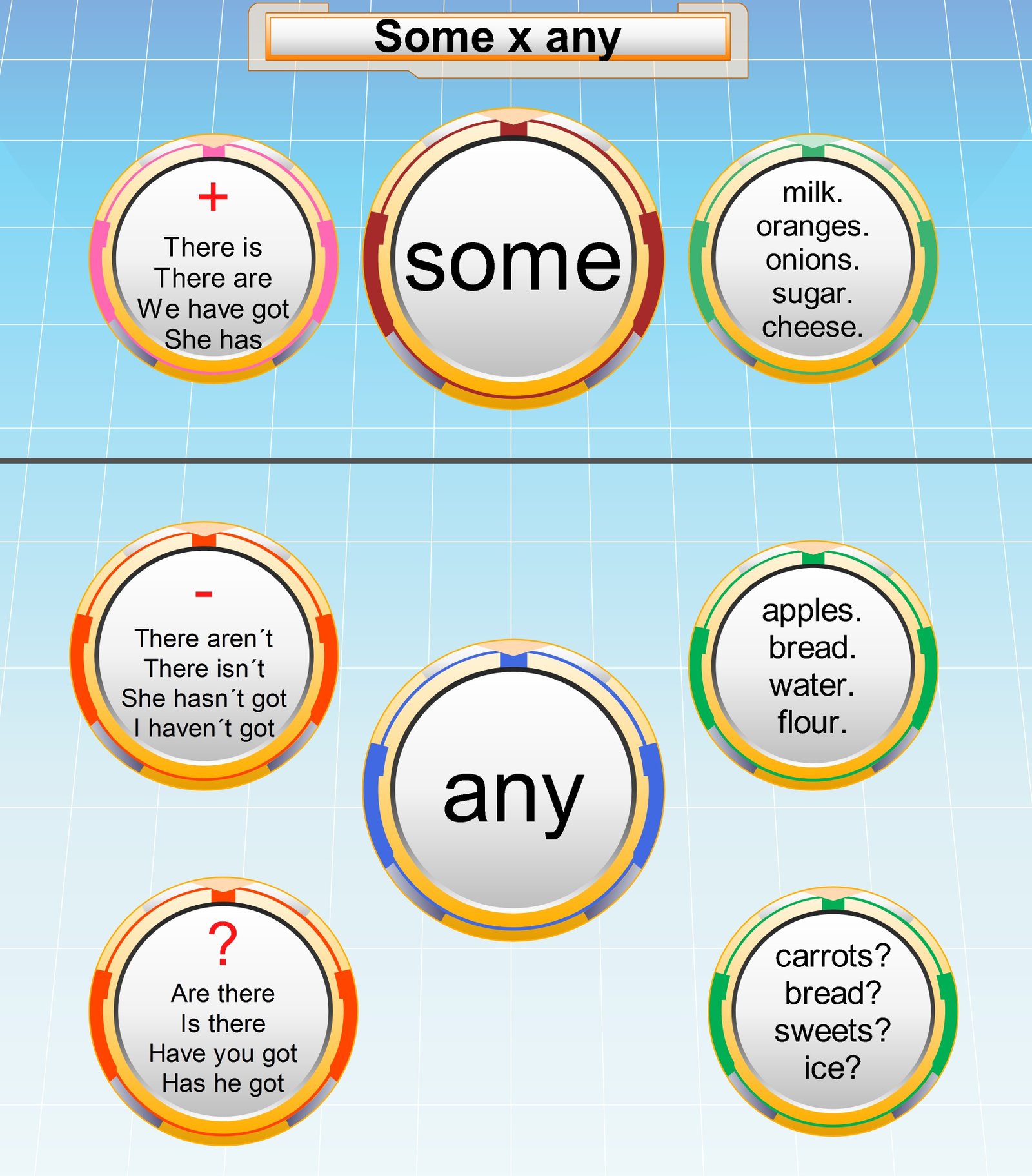
Once I elicit the usage of the two words, I verify the students knowledge with the following exercises and games.
Some and Any – exercises and games
The first quiz is created in HTML 5 so it will play on all mobile devices. It is not a bad idea to ask your students from time to time to use their mobiles and do the exercise online. They will feel happy that they can use their mobile phones or tablets at school.
Some and Any quiz – full screen
The second game is called On target and students at school love it. Your aim is to choose the correct answer and then shoot as many bad ducks as possible. Moreover, you can get a bonus if you shoot one of the bottles on the side. This game is in flash and therefore will work only on desktops.
Some and Any quiz – full screen
If you do not have an interactive whiteboard at school, you will appreciate the print version of the quiz:
If you feel that there are not enough exercises at this site you can visit British Council site and learn more about SOME and ANY there.
Blog competition
 Macmillan publishing house runs a competition Love English Awards and as this site has been nominated, you can vote for us here. Thank you for your support.
Macmillan publishing house runs a competition Love English Awards and as this site has been nominated, you can vote for us here. Thank you for your support.
How much and How many – share
If you like the two games above and you would like to share them on your blog or use them in a classroom without an internet connection, you can do this. You can download all the files here:


